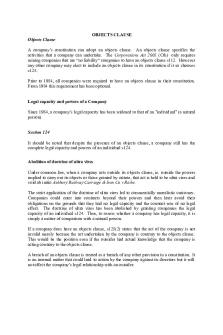Programming - Representing Objects PDF

| Title | Programming - Representing Objects |
|---|---|
| Course | Introduction to programming |
| Institution | University of Greenwich |
| Pages | 4 |
| File Size | 151.1 KB |
| File Type | |
| Total Downloads | 13 |
| Total Views | 144 |
Summary
Download Programming - Representing Objects PDF
Description
Programming - Representing Objects Assignment (set! name expression) Changes the value bound to a name to the value of an expression. The name must already be defined and exist in the environment which set! is evaluated. The Substitution Model To evaluate a compound procedure, evaluate the body of the procedure with each formal parameter replaced by the value of the corresponding argument. There are problems with global variables to store state. There may be multiple instances of items and global variables decrease modularity. To work round this, you can encapsulate state within an object. An object must have internal state and be active. You tell the object what to do with the state rather than do it directly. In Scheme, objects are represented by procedures with local state variables. There are 4 programming paradigms:
functional imperative logic object-orientated (sometimes called message-passing)
The Environment Model of Evaluation The substitute model doesn't work when assignment is involved. An environment is made of frames, where frames are tables of bindings (names and values) and a pointer to the enclosing environment. In a frame, a variable can be bound, unbound, the first binding or a "shadow" binding (overriding any earlier bindings). A procedure is the code and pointer to an environment. This is the environment in which the lambda expression defining the pointer was evaluated.
e.g., "blood-donor" is an object which has state (quantity of blood) and responds to "drain" requests. A constructor of blood donors takes a quantity of blood and returns a blood donor object. This object is itself a procedure which responds to requests (drain, etc) and then returns the procedure to do that event, which itself may take multiple arguments. An object needs to be defined with initial states, the object procedure and request handling procedures. The object constructor should return the object. Mutators Primitive Data Compound Data Creation 1, 'x, #f Constructors cons Selectors car, cdr Assignment set! Mutators set-car!, set-cdr! Pointers Box and Pointer Diagrams (cons x y) creates a new pair
The contents of the pair are pointers. A list terminator can be represented as follows:
e.g., '(1 2 3) is the short form of (cons 1 (cons 2 (cons 3 (nil))))
Equality =, two numerical values are the same eq?, two pointers are the same equal?, two structures are the same (here, it is the representation of the structures that are compared) Say we create 2 structures, (cons x 'a 'b) and (cons z1 x x)
We can now do (set-car! (cdr z1) 'boom) which changes 'a in the structure to 'boom. This now makes z1 (('boom 'b) 'boom 'b) and x is now ('boom 'b). However, if we (cons z2 (list 'a 'b) (list 'a 'b)), this makes z1 equal? to z2, but now (set-car! (cdr z2) 'boom) gives us (('a 'b) 'boom 'b) Association List An association list is a list of records, each of which consists of a key and a value. Each record is a pair formed by (cons key value). e.g., ((answer . 23) ('y . #t) ('z . "Hello")) associates answer with 23, y with #t and z with "Hello". The procedure (retrieve key associations) returns the first pair in associations which has key in its car or returns nil if there is no such record....
Similar Free PDFs

Huffman Representing Her Beliefs
- 4 Pages

Lecture 2 Representing Motion
- 8 Pages

Holy cow as representing
- 4 Pages

Certainty of objects - helpful notes
- 15 Pages

Objects Classes Tut 3
- 3 Pages

Objects Links - Table Format
- 4 Pages

Extra Notes on Objects Clause
- 1 Pages

Seminar 4 certainty of objects
- 13 Pages

MY Favorite Personal Objects
- 1 Pages

Certainty of objects
- 4 Pages

Mental Rotation 3D Objects
- 4 Pages

Extra Notes on Objects Clause
- 1 Pages

Class and objects - IT Learning
- 10 Pages
Popular Institutions
- Tinajero National High School - Annex
- Politeknik Caltex Riau
- Yokohama City University
- SGT University
- University of Al-Qadisiyah
- Divine Word College of Vigan
- Techniek College Rotterdam
- Universidade de Santiago
- Universiti Teknologi MARA Cawangan Johor Kampus Pasir Gudang
- Poltekkes Kemenkes Yogyakarta
- Baguio City National High School
- Colegio san marcos
- preparatoria uno
- Centro de Bachillerato Tecnológico Industrial y de Servicios No. 107
- Dalian Maritime University
- Quang Trung Secondary School
- Colegio Tecnológico en Informática
- Corporación Regional de Educación Superior
- Grupo CEDVA
- Dar Al Uloom University
- Centro de Estudios Preuniversitarios de la Universidad Nacional de Ingeniería
- 上智大学
- Aakash International School, Nuna Majara
- San Felipe Neri Catholic School
- Kang Chiao International School - New Taipei City
- Misamis Occidental National High School
- Institución Educativa Escuela Normal Juan Ladrilleros
- Kolehiyo ng Pantukan
- Batanes State College
- Instituto Continental
- Sekolah Menengah Kejuruan Kesehatan Kaltara (Tarakan)
- Colegio de La Inmaculada Concepcion - Cebu


